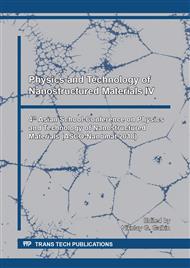[1]
L.V. Kiseleva, S.V. Tokar, M.N. Panina, Thermal control coating of the solar reflector, class for carbon fiber products (options), Patent of Russia No. 2574620 dated February 10, (2016).
Google Scholar
[2]
L.G. Kositsyn, M.M. Mikhailov, N.Y. Kuznetsov, M.I. Dvoretskii, Apparatus for study of diffuse - reflection and luminescence spectra of solids in vacuum, Instruments and Experimental Techniques. 28 (1985) 929.
Google Scholar
[3]
M.M. Mikhailov, V.V. Neshchimenko, Chundong Li, Optical properties of zinc oxide powders modified by nanoparticles ZrO2, Al2O3, TiO2, SiO2, CeO2 and Y2O3 with various concentrations, Dyes and Pigments. 131 (2016) 256-263.
DOI: 10.1016/j.dyepig.2016.04.012
Google Scholar
[4]
V.V. Neshchimenko, Chundong Li, M.M. Mikhailov. Radiation stability of TiO2 hollow particles pigments and coatings synthesis by hydrothermal methods from TTIP, Dyes and Pigments. 145 (2017) 354-358.
DOI: 10.1016/j.dyepig.2017.03.058
Google Scholar
[5]
A.S. Marfunin, Spectroscopy, Luminescence and Radiation Centers in Minerals, first ed., Springer, (1979).
Google Scholar
[6]
V.Z. Bartoshinsky, A.A. Shumsky, A.L. Larikov, L.S. Dersky, Paramagnetic and optically active centers in barites of the Ukraine, Mineralogicheskii Zhurnal. 13 (1991) 73-78 (in Russian).
Google Scholar
[7]
A.N. Platonov, Identity of color in minerals, Naukova Dumka, Kiev, 1976 (in Russian).
Google Scholar
[8]
M.A. Sharaf, Gamal M. Hassan, Radiation induced radical in barium sulphate for ESR dosimetry: a preliminary study, Nuclear Instruments and Methods in Physics Research Section B: Beam Interactions with Materials and Atoms, 225(4) (2004) 521-527.
DOI: 10.1016/j.nimb.2004.05.025
Google Scholar
[9]
L. R. Bernstein, Coloring mechanisms in celestite, American Mineralogist. 64 (1979) 160-168.
Google Scholar
[10]
V.A. Grevtsev, Minerological and technological evaluation of non-metallic minerals by radio spectroscopy. The published summary of a thesis for the degree of Doctor of Sciences in geology and mineralogy, Russian Federation, Kazan, Kazan Federal University, 2011, 34 p. (in Russian).
DOI: 10.26907/mrsej-19300
Google Scholar


